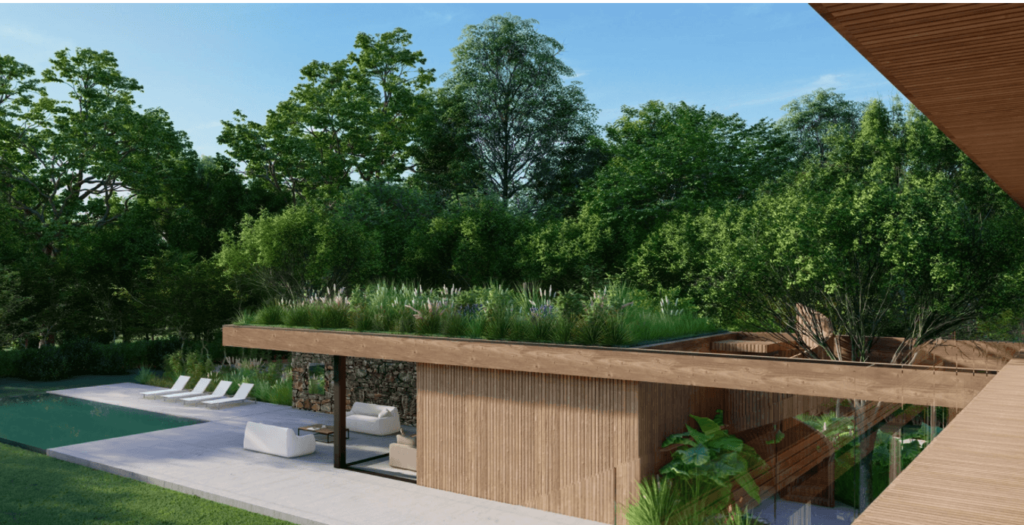The increasing popularity of green roofs in U.S. urban environments has structural engineers, developers and architects looking up these days. Over the past 10-15 years, green roofs have begun to appeal to building owners in U.S. cities. This trend only promises to increase as property owners see this roof as a way to embrace environmentalism. Although trending now in the United States, living roofs are far from a new concept. They have been in use around the world, in one form or another, for hundreds of years with the earliest versions in Iceland. Europe saw its first modern green roof in the 1960’s; when Germany discovered that vegetation on a roof could help with storm water management. As this trend continues, the many benefits of a green roof are becoming even more apparent.
Other than the obvious aesthetic benefit, installing a green roof offers a multitude of other advantages. By growing plants on a building’s roof top, owners are effectively replacing the vegetated footprint that was destroyed or will be destroyed during construction. However, the advantages don’t stop there.
Green roofs hold numerous environmental benefits. The EPA has reported that vegetated roofs help to reduce water runoff by as much as 75%. While they also work to filter whatever water runoff does occur. Green roofs improve air quality in the surrounding environment. Rooftop plants will naturally filter noxious gases and help to rid the air of pollutants. The plant life on a green roof can extend the roof’s life by protecting it from UV rays and other natural elements that wreak havoc on roofing materials. Vegetated roofs have proven to reduce energy costs substantially. They achieve this by acting as natural insulators against the cold and heat, and thus improve a building’s energy efficiency.
Besides the above-mentioned benefits, green roofs offer an aesthetically pleasing and healthy environment to work and live. In an urban environment where green space is scarce or at a premium, a living roof can offer anyone a place to relax and enjoy nature. Living roofs can be used as recreational spaces such as playgrounds or community gardens. These green havens increase biodiversity by providing vital habitats for species of plants and animals.
The green roof atop the Jacob Javits Convention Center in New York City is clear proof of the practical benefits of a living roof. This massive convention center has a six-block footprint and before 2014, its roof was completely barren. It is now the largest green roof in New York City. [Alan Steel, the CEO of the Javits Center reports that this eco-friendly roof boasts 300,000 bees, 25 different species of birds, a reduced temperature of six degrees and a 26% reduction in energy that saves the convention center three million dollars a year.] The roof’s soil and plants absorb seven million gallons of storm water runoff. With statistics such as these, it is easy to see how a green roof can improve urban work, school, and home environments significantly. However, New York is not the only city reaping the benefits of green roofs. Major initiatives are happening in other U.S. cities such as Chicago, Portland OR and Washington D.C.
Trending green roofs are also being built as urban produce gardens for tenants to manage. Some say rooftop farms are the definitive wave of the future. In fact, ecoroofs around the world sprout vegetable gardens and many of these rooftop gardens link to restaurants. Restauranteurs are choosing to utilize their roof space to grow fresh vegetables and herbs. These owners see the value in sharing fresh, homegrown produce with their customers. Rooftop agriculture is also producing crops such as grains and fruits along with vegetables.
As building owners continue to see the value of installing a green roof, they are also deciding on which type of living roof will best suit their needs. The two specific types of vegetated roofs in common use today are intensive and extensive.
Extensive green roofs usually contain one to six inches of soil, which means they can support only certain types of plants. These roofs are lighter in weight and have lower maintenance, nutrient, and irrigation requirements than intensive living roofs. Examples of plants used on an extensive roof, range from sedums to small grasses, herbs and flowering herbaceous plants which need little maintenance and no permanent irrigation system.
Intensive green roofs, on the other hand, contain at least six inches of soil or more and will support a wide variety of plant types. Plant options can include full-grown trees and shrubs. These roofs are quite heavy and require a lot of maintenance.
In the past few years, it is no longer a question of whether to go green. But more of a question of where and how to go green. Living roofs have been the answer to those questions. Green roofs provide a resolution for those seeking to turn a harsh urban environment into a sustainable, bucolic landscape. Living roofs improve a society’s quality of life. Their benefits are increasingly being identified, measured, and acknowledged by building owners and by the general public. Denver has just become the latest city to require rooftop gardens or solar panels on large, new buildings. Will this trend continue? Increased government support, new laws and incentive programs to install green roofs will help to ensure that the green roof trend in the U.S. will continue long into the future.
Whether retrofitting a building with a contemporary green roof or starting from scratch, the load bearing capacity of a building must be determined first by a certified, structural engineer before plans for a green roof can begin. As part of your team, e2 engineers offer our extensive experience to ensure comprehensive green roof design development based on a building’s construction, condition, and weight loading capacity. Not your average engineers, e2 engineers can help guide your decisions as you watch your green roof plans come to life.

